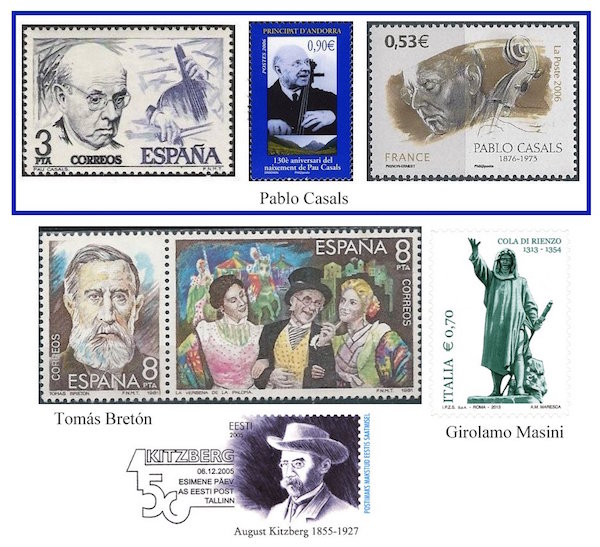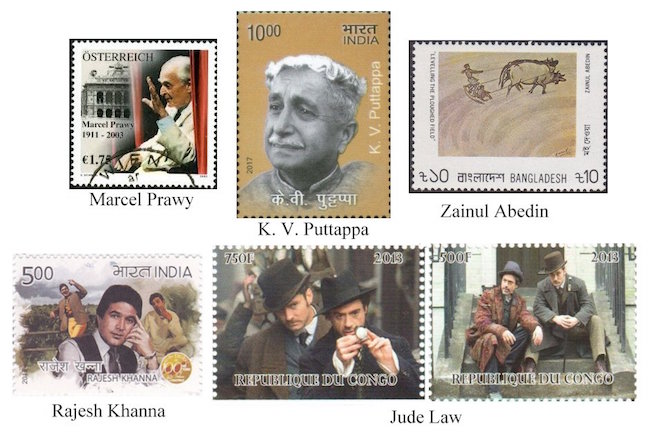The Arts on Stamps of the World — December 29
An Arts Fuse regular feature: the arts on stamps of the world.

By Doug Briscoe
People of Hispanic ethnicity and those from India would seem to dominate the proceedings today.
I offer three stamps for Pablo Casals (December 29, 1876 – October 22, 1973), who was born Pau Casals i Defilló. The first was issued by Spain for the cellist’s centenary, and the other two, from France and Andorra, came out in 2006. We saw a fourth, a Mexican stamp, just the other day on the occasion of the anniversary of the first performance of Casals’s oratorio El Pessebre. (There’s a fifth one from Antigua, but I don’t have it.) Casals learned music from his father, a parish organist and choirmaster, and decided on the cello at the age of 11. By the time he was 14 he was ready to give a recital in Barcelona. No less a figure than Albéniz heard him playing in a café and, through the composer’s offices, Casals began to give informal concerts at the royal palace and received a stipend so that he could continue his studies in Madrid. In 1899 he played for Queen Victoria and over the next few years made tours of Spain and the Netherlands (with pianist Harold Bauer), the United States, and South America. In the year 1904 he played at the White House for Theodore Roosevelt and made his Carnegie Hall debut. After organizing his famous trio with Alfred Cortot and Jacques Thibaud in Paris, he took up conducting and founded his own orchestra, the Pau Casals Orchestra. With the onset of the Spanish Civil War he became so staunch a Republican that for the rest of his life he refused to play not only in Franco’s Spain but even in countries that recognized the Franco government. The one exception was his famous White House appearance for John F. Kennedy in 1961. Casals was thrice married: to the socialite and singer Susan Metcalfe in 1914, to Francesca Vidal de Capdevila in 1955 (she died that same year), and, somewhat controversially, to Marta Montañez y Martinez, who was 60 years his junior, in 1957. (She went on to marry the pianist Eugene Istomin.) Casals died in Puerto Rico at the age of 96.
Another Spanish musician born on this date was Tomás Bretón y Hernández (1850 – 2 December 1923) of Salamanca. He shared first prize for composition at the Royal Conservatory with Ruperto Chapí in 1872, founded the Unión Artístico Musical in 1878, and was principal conductor of the Madrid Concert Society from 1885 to 1891. As a composer, he is best known for his works for the stage, with nine operas and some four dozen zarzuelas (one of which, La Verbena de la paloma, is referenced on the adjacent se-tenant stamp), but he also produced three symphonies, a number of symphonic poems, an oratorio, El Apocalipsis (1882), and chamber music.
A decade older than Bretón, Italian sculptor Girolamo Masini (December 29, 1840 – December 21, 1885) was born in Florence. His best known work is the bronze statue of Cola di Rienzi (1877) found at the foot of Rome’s Capitoline Hill. An image of the statue was used for the stamp commemorating the 700th anniversary of the birth of Rienzi.
Although there is no stamp, Estonian playwright August Kitzberg (29 December [O.S. 17 December] 1855 – 10 October 1927) does have a piece of postal stationery dedicated to him. He was a newspaper editor while writing his early comedies and humorous stories. Kitzberg’s later work evinces a concern with social issues. Besides the stories and sixteen plays composed between 1894 and 1923, there is a two-volume memoir from 1924-25.

The name of Mexican social realist painter David Alfaro Siqueiros (1896 – January 6, 1974) is grouped with those of Diego Rivera and José Clemente Orozco as the founders of “Mexican Muralism”. Inclined from an early age to rebel, he took part in a strike when he was fifteen and fought against Huerta at eighteen. In these struggles he sympathized with the poor and became a Communist, was jailed, exiled, spent most of 1938 fighting Franco in Spain, personally took part in an assassination attempt on the life of Trotsky in 1940, and was imprisoned again, this time for four years, between 1960 and 1964, being released only after an international campaign. But let’s talk about the art. He began painting murals as early as 1922, following his return from a European visit. During the aforementioned exile, he went to the United States, where for Los Angeles he painted a mural called Tropical America (1932); with its crucified indigenous figure beneath an eagle ( = American imperialism), this was interpreted by many as Communist propaganda and was eventually whitewashed in 1938. (It was restored just a few years ago and now adjoins a center devoted to the artist.) Siqueiros (with Rivera and Orozco) was part of the first Mexican contingent at the XXV Venice Biennale in 1950 and received second prize. His Self-Portrait (The Great Colonel, 1945) was chosen for two stamps in Siqueiros’s memory, from 1975 and 1996. For the centenary of his birth, Chile issued a souvenir sheet of his mural Cuauhtémoc Against the Myth (1944), which shows the Aztec emperor wielding a fanciful weapon against invading Christianity (note the upraised dagger in the form of a cross).
Another Latin American visual artist who strove to present the struggles and essence of his people in his work was the Brazilian painter Cândido Portinari (December 29, 1903 – February 6, 1962). (He was a Communist Party member, too, if less, shall we say, bellicose.) The importance given to Portinari by his nation may be assessed by the number of stamps showing his work. He was born near São Paulo to Italian immigrants and studied art in Rio. After two prolonged visits to Paris between 1928 and 1933, he returned home and began using what he had learned to express his conception of his homeland. His pieces were shown at the 1939 New York World’s Fair and at MOMA in 1940. Like Siqueiros, he was at one point forced to flee his country, in Portinari’s case, living in Uruguay between 1947 and 1952. Four years later a more favorably inclined government chose him to represent Brazil with an art work that was to be donated to the United Nations. This was a pair of murals, War and Peace, which Dag Hammarskjöld called “the most important monumental work of art donated to the UN.” A detail from Peace appears on a 1974 UN stamp shown at bottom right. Of the six Brazilian Portinari stamps I found, three, the ones at bottom center, form a group: Negrinha, Sitting Boy and Ram (Menino sentado e carneiro), and Portrait of Marcel Gontrau. At the left of the Siqueiros display is the artist’s Self-Portrait, at right his Coffee Worker (Portinari grew up on a coffee plantation), and, at bottom left, First Mass Celebrated in Brazil.
The Austrian opera-lover, teacher, and critic Marcel Prawy was born Marcel Horace Frydmann, Ritter von Prawy on this date in 1911. The scion of Jewish Austro-Hungarian nobility, he became the tenor Jan Kiepura’s secretary and, with him, left Austria for the US to escape Nazism. When he returned to Europe after the war, he introduced the Viennese to the musical Kiss Me, Kate and helped establish a taste for German language musicals. His first love, though, remained opera and operetta. He was a dramaturg at the Vienna Volksoper and Vienna State Opera, as well as a professor and lecturer; his radio and television broadcasts on opera earned him the affection and devotion of a wide audience. Marcel Prawy died at age 91 on 23 February 2003.

Perhaps the principal writer in the Kannada language (spoken in Karnataka in the southwest of India) was Kuppali Venkatappa Puttappa (29 December 1904 – 11 November 1994), known as K. V. Puttappa or by the nickname Kuvempu. He attended the Maharaja College of Mysore, which had been established in 1916, and would teach there for some thirty years (beginning in 1929, the year of his graduation) and eventually become the institution’s Vice-Chancellor (1956-60). His initial writings were in English, but soon he switched to his native Kannada, which he promoted as an official language. Puttappa was an opponent of the caste system and meaningless ritual. His greatest work is probably the epic narrative Sri Ramayana Darshanam (in two volumes, 1949 and 1957), a retelling of an ancient Hindu epic. Primarily a poet, Puttappa also wrote plays, stories, some of them for children, criticism, and two novels. One of those, Kanooru Heggadithi (Mistress of the House of Kanooru, 1936), was made into a film in 1999. He also left a volume of memoirs (1980) and wrote the words for the Karnataka State Anthem.

We pass to the other side of the subcontinent for Bengali painter Zainul Abedin (29 December 1914 – 28 May 1976). He grew up by the Brahmaputra River, which would often figure in his paintings. Some of these earned him a Governor’s Gold Medal in a 1938 all-India exhibition. He attended Calcutta Government Art School and was the first Muslim to receive first class distinction there. In 1943, moved by the plight of the victims of the Great Famine of Bengal, Abedin made many sketches, some of which formed the basis for a series of paintings that received much notice. He lived in Pakistan after the partition and co-founded an art institute in Dhaka in 1948. Much later, in 1970, he visited Palestinian refugee camps in Syria and Jordan and produced some 60 or 70 paintings of the people. In 1975 he founded a folk art museum and a gallery of his own works. Abedin died of lung cancer at 61. His picture Leveling the Ploughed Field appears on a stamp of Bangladesh.
Remaining in the region, but again crossing the subcontinent, we come to one of the biggest stars in Hindi film, actor Rajesh Khanna (29 December 1942 – 18 July 2012), born in Punjab. His work has been so highly regarded that he was officially styled The First Superstar of Indian Cinema at the Dadasaheb Phalke Award ceremony in 2013. He made his film debut in 1966 after winning a talent competition and between 1969 and 1971 had an unparalleled string of fifteen (or seventeen) consecutive hits, with many other hits to follow. He took a break from acting to serve in the Indian National Congress from 1992 to 1996.
Another actor who’s had a fair number of hit movies is London-born Jude Law (born 29 December 1972). He first appeared in film in 1992 and has twice been nominated for Oscars: Best Supporting Actor for The Talented Mr. Ripley (1995) and Best Actor for Cold Mountain (2003). On stamps he shows up as Dr. Watson opposite the athletic Sherlock Holmes of Robert Downey Jr.
A graduate of the University of Massachusetts with a B.A. in English, Doug Briscoe worked in Boston classical music radio, at WCRB, WGBH, and WBUR, for about 25 years, beginning in 1977. He has the curious distinction of having succeeded Robert J. Lurtsema twice, first as host of WGBH’s weekday morning classical music program in 1993, then as host of the weekend program when Robert J.’s health failed in 2000. Doug also wrote liner notes for several of the late Gunther Schuller’s GM Recordings releases as well as program notes for the Boston Classical Orchestra. For the past few years he’s been posting a Facebook “blog” of classical music on stamps of the world, which has now been expanded to encompass all the arts for The Arts Fuse.
